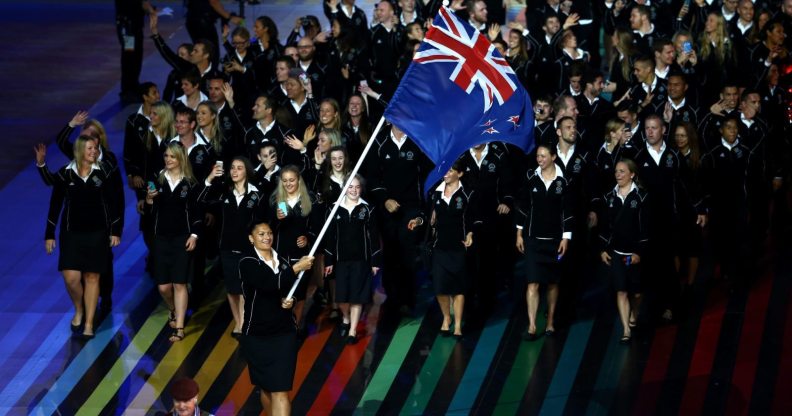Backlash as transgender weightlifter qualifies for Commonwealth Games

(Richard Heathcote/Getty Images)
(Richard Heathcote/Getty Images)
Laurel Hubbard has been named to the New Zealand women’s weightlifting team for the Commonwealth Games, sparking controversy in the sport.
Hubbard, 39, will be the first transgender sportsperson to represent New Zealand.
After being cleared by the International Olympic Committee and Olympic Weightlifting New Zealand (OWNZ) last week, it was confirmed that she would be one of 12 athletes in the Kiwi home state’s weightlifting team on the Gold Coast.
Hubbard will compete in the women’s +90kg category, introduced by the International Weightlifting Federation at the start of the year.

Laurel Hubbard winning the 90kg+ division in the Australian International in Melbourne, March 18, 2017 (News.com.au)
However, not all reaction to Hubbard’s selection has been positive.
Australian Weightlifting Federation chief executive Michael Keelan on Friday claimed Hubbard would have both a physiological and mental edge over her rivals.
Speaking to the Australian Associated Press, Keelan noted that: “If you’ve been a male and you’ve lifted certain weights and then you suddenly transition to a female, then psychologically you know you’ve lifted those weights before.
“I personally don’t think it’s a level playing field. That’s my personal view and I think it’s shared by a lot of people in the sporting world.”

A Venezuelan weightlifter competes during the XVIII Bolivarian Games 2017 in Santa Marta, Colombia (LUIS ACOSTA/AFP/Getty Images)
Keelan’s comment is a surprising curve from his previously positive response to Hubbard.
After winning the +90kg in the Australian International, Melbourne earlier this year, Keelan voiced his admiration: “It’ll be interesting to see how much support she gets from the community, but I would think she’s on the cusp of creating a lot of history.
“And she could be a great role model for others to follow,” he said speaking to the New Zealand Herald in March.

Luisa Peters (Ryan Pierse/Getty Images)
Earlier in her career, Hubbard was a national junior record-holder in the male 105kg class before she transitioned in her mid-30s.
She became the first transgender athlete to win an international weightlifting title for New Zealand and Australia earlier this year in the Australian Open, lifting 123 kilos in the snatch and 145 in the clean and jerk.
Since the announcement, Hubbard has sustained a low-profile and is refusing to do media interviews, but Olympic Weightlifting New Zealand said she met International Olympic Committee regulations related to acceptable testosterone levels.

(Sandra Mu/Getty Images)
A spokesperson for the Gold Coast 2018 Commonwealth Games Corporation said organisers planned to make the event “the most accessible and inclusive Games in history”.
But Olympic Weightlifting New Zealand president Garry Marshall said previously: “She competed for a long time as a man and her efforts were very strong. That strength has remained with her despite reduced testosterone.
“That point is not recognised by the science and some of our competitors would say that’s not fair.”
Whilst Hubbard remains a trailblazer in trans-inclusivity in sports by the Pacific Ocean, transgender Hannah Mouncey was blocked from being drafted into the Australian Women’s Football League.
Concerns over both Hubbard and Mouncey are on the grounds of conceived advantages their physical strength and stamina would provide them over opponents.
Regulations on transgender athletes defined by the International Olympic Committee were relaxed last year, allowing trans people to take part without undergoing gender surgery.
Previous rules banned trans and intersex people from taking part in sports unless they met a string of requirements.
However, in a bid to resolve some of the issues, the International Olympic Committee adopted a more relaxed policy.
Restrictions on trans men taking part in men’s events were largely lifted.
Trans women still face some obstacles to taking part in women’s events, requiring a consistent testosterone level “below 10 nmol/L” – but there is no longer a restriction relating to gender surgery.
The guidelines explain: “It is necessary to ensure insofar as possible that trans athletes are not excluded from the opportunity to participate in sporting competition.
“To require surgical anatomical changes as a pre-condition to participation is not necessary to preserve fair competition and may be inconsistent with developing legislation and notions of human rights.”
The issue has come into the limelight previously, most notably when South African sprinter Caster Semenya was subjected to a humiliating ‘gender test’ in 2009.
Semenya, who is chromosomally female, is believed to have a rare hyperandrogenist intersex condition that leads to the production of more testosterone than usual.
She fought a long battle to compete at the highest level, and took part in the Olympics in 2016 after the regulations were changed.
The sprinter was found to have no biological advantage over other women, but after Semenya won a gold medal, one bitter rival said she had an “unfair” advantage.

